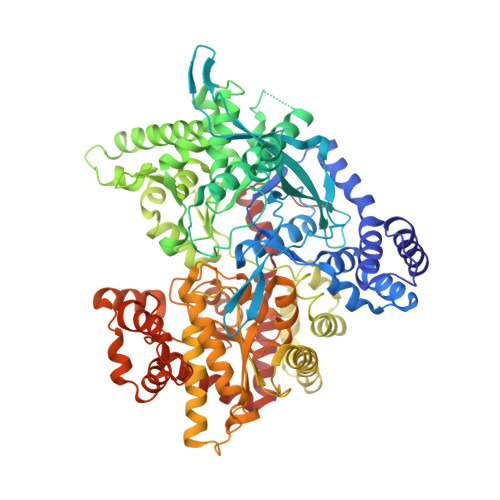Thermodynamic characterization of allosteric glycogen phosphorylase inhibitors.
Anderka, O., Loenze, P., Klabunde, T., Dreyer, M.K., Defossa, E., Wendt, K.U., Schmoll, D.(2008) Biochemistry 47: 4683-4691
- PubMed: 18373353
- DOI: https://doi.org/10.1021/bi702397d
- Primary Citation of Related Structures:
3CEH, 3CEJ, 3CEM - PubMed Abstract:
Glycogen phosphorylase (GP) is a validated target for the treatment of type 2 diabetes. Here we describe highly potent GP inhibitors, AVE5688, AVE2865, and AVE9423. The first two compounds are optimized members of the acyl urea series. The latter represents a novel quinolone class of GP inhibitors, which is introduced in this study. In the enzyme assay, both inhibitor types compete with the physiological activator AMP and act synergistically with glucose. Isothermal titration calorimetry (ITC) shows that the compounds strongly bind to nonphosphorylated, inactive GP (GPb). Binding to phosphorylated, active GP (GPa) is substantially weaker, and the thermodynamic profile reflects a coupled transition to the inactive (tense) conformation. Crystal structures confirm that the three inhibitors bind to the AMP site of tense state GP. These data provide the first direct evidence that acyl urea and quinolone compounds are allosteric inhibitors that selectively bind to and stabilize the inactive conformation of the enzyme. Furthermore, ITC reveals markedly different thermodynamic contributions to inhibitor potency that can be related to the binding modes observed in the cocrystal structures. For AVE5688, which occupies only the lower part of the bifurcated AMP site, binding to GPb (Kd = 170 nM) is exclusively enthalpic (Delta H = -9.0 kcal/mol, TDelta S = 0.3 kcal/mol). The inhibitors AVE2865 (Kd = 9 nM, Delta H = -6.8 kcal/mol, TDelta S = 4.2 kcal/mol) and AVE9423 (Kd = 24 nM, Delta H = -5.9 kcal/mol, TDelta S = 4.6 kcal/mol) fully exploit the volume of the binding pocket. Their pronounced binding entropy can be attributed to the extensive displacement of solvent molecules as well as to ionic interactions with the phosphate recognition site.
- Research and Development, Sanofi Aventis Deutschland GmbH, Frankfurt am Main, Germany. oliver.anderka@sanofi-aventis.com
Organizational Affiliation:



















